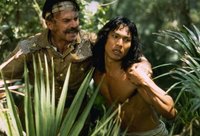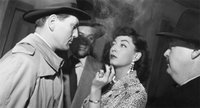Rudyard Kipling's The Jungle Book (1994)
 This is a Disney movie. Get over it. There are lots of things that you could say about this movie that give the wrong impression--it's Disney, it's got crappy 1994 effects, it's only rated PG, it's based on Kipling's Jungle Book, and it has Jason Scott Lee, a pretty hit-or-miss actor. In its defense, I would say that it is not characteristic of Disney at all, it has very little resemblance to the animated movie of the same name (or to the original books), and despite its PG rating, it's a rather adult movie, especially for a Disney feature.
This is a Disney movie. Get over it. There are lots of things that you could say about this movie that give the wrong impression--it's Disney, it's got crappy 1994 effects, it's only rated PG, it's based on Kipling's Jungle Book, and it has Jason Scott Lee, a pretty hit-or-miss actor. In its defense, I would say that it is not characteristic of Disney at all, it has very little resemblance to the animated movie of the same name (or to the original books), and despite its PG rating, it's a rather adult movie, especially for a Disney feature.It's more a sequel rather than a retelling of the classic Jungle Book tale of a boy who grows up in the jungle and befriends the animals. In this movie, Mowgli, after living in the jungle until adulthood and completely losing touch with society, is thrown back into the mix when he stumbles across British soldiers in colonial India. Some corrupt soldiers get wind of a mythical place in the jungle said to contain mountains of treasure, and they kidnap Mowgli and force him to take them there. In the middle of all this is a love affair between Mowgli and Kitty, a general's daughter, a crush that has been going on since their childhood together. There are also undertones of racism, class distinction, and social formalities both necessary and archaic.
Since this was a lower-tier Disney production, it does have its "cute" moments, especially in the beginning when Mowgli is a child, as well as some special effects which are patchy at best. The script is tight, but often too simplistic. But when the film gets past the Disneyisms and dated effects, it transcends its studio's stereotype with the help of positively gorgeous cinematography and a majestic score by Basil Poledouris. It shows that a film can be enjoyable by both children and adults without being overlong, dependent on flashy special effects, rife with pretentious heavyweight actors, or dumbed down to its younger audience members. It also avoids unnecessary violence or language, something attributed to more "adult" films that often end up being more juvenile (Pirates of the Caribbean: The Curse of the Black Pearl). Nevertheless, it maintains a more serious tone, as well as a sense of adventure and fun that never loses focus.
While not a great film by any means, Rudyard Kipling's The Jungle Book is some of the best family fare you can get your hands on. I consider it superior to Pirates of the Caribbean: The Curse of the Black Pearl, Star Wars: Episode III - Revenge of the Sith, or any of the other more "adult" family movies coming out these days. This is surely a neglected film, seldom judged on its own merit.

